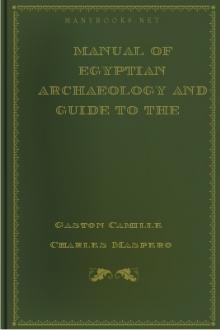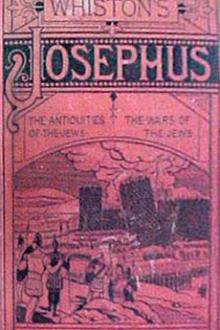Manual of Egyptian Archaeology and Guide to the Study of Antiquities in Egypt by Gaston Maspero (i have read the book txt) 📕

107. Wall-scene from temple of Denderah
108. Obelisk of Heliopolis, Twelfth Dynasty
109. Obelisk of Begig, Twelfth Dynasty
110. "Table of offerings" from Karnak
111. Limestone altar from Menshîyeh
112. Wooden naos, in Turin Museum
113. A mastaba
114. False door in mastaba
115. Plan of forecourt, mastaba of Kaäpir
116. Plan of forecourt, mastaba of Neferhotep
117. Door in mastaba façade
118. Portico and door of mastaba
119. Plan of chapel, mastaba of Khabiûsokari
120. Plan of chapel, mastaba of Ti
121. Plan of chapel, mastaba of Shepsesptah
122. Plan of chapel, mastaba of Affi
123. Plan of chapel, mastaba of Thenti
124. Plan of chapel, mastaba of Red Scribe
125. Plan of chapel, mastaba of Ptahhotep
126. Stela in mastaba of Merrûka
127. Wall-scene from mastaba of Ptahhotep
128. Wall-scene from mastaba of Ûrkhûû
129. Wall-scene from mastaba of Ptahhotep
130. Plan of serdab in mastaba at Gizeh
131. Plan of serdab and
Read free book «Manual of Egyptian Archaeology and Guide to the Study of Antiquities in Egypt by Gaston Maspero (i have read the book txt) 📕» - read online or download for free at americanlibrarybooks.com
- Author: Gaston Maspero
- Performer: -
Read book online «Manual of Egyptian Archaeology and Guide to the Study of Antiquities in Egypt by Gaston Maspero (i have read the book txt) 📕». Author - Gaston Maspero
2.--TECHNICAL PROCESSES.
The preparation of the surface about to be decorated demanded much time and care. Seeing how imperfect were the methods of construction, and how impossible it was for the architect to ensure a perfectly level surface for the facing stones of his temple-walls and pylons, the decorator had perforce to accommodate himself to a surface slightly rounded in some places and slightly hollowed in others. Even the blocks of which it was formed were scarcely homogeneous in texture. The limestone strata in which the Theban catacombs were excavated were almost always interspersed with flint nodules, fossils, and petrified shells. These faults were variously remedied according as the decoration was to be sculptured or painted. If painted, the wall was first roughly levelled, and then overlaid with a coat of black clay and chopped straw, similar to the mixture used for brick- making. If sculptured, then the artist had to arrange his subject so as to avoid the inequalities of the stone as much as possible. When these occurred in the midst of the figure subjects, and if they did not offer too stubborn a resistance to the chisel, they were simply worked over; otherwise the piece was cut out and a new piece fitted in, or the hole was filled up with white cement. This mending process was no trifling matter. We could point to tomb-chambers where every wall is thus inlaid to the extent of one quarter of its surface. The preliminary work being done, the whole was covered with a thin coat of fine plaster mixed with white of egg, which hid the mud-wash or the piecing, and prepared a level and polished surface for the pencil of the artist. In chambers, or parts of chambers, which have been left unfinished, and even in the quarries, we constantly find sketches of intended bas-reliefs, outlined in red or black ink. The copy was generally executed upon a small scale, then squared off, and transferred to the wall by the pupils and assistants of the master.
Fig 178.--Sculptor's sketch from Ancient Empire tomb. Fig 178.--Sculptor's sketch from Ancient Empire tomb.
As in certain scenes carefully copied by Prisse from the walls of Theban tombs, the subject is occasionally indicated by only two or three rapid strokes of the reed (fig. 178). Elsewhere, the outline is fully made out, and the figures only await the arrival of the sculptor. Some designers took pains to determine the position of the shoulders, and the centre of gravity of the bodies, by vertical and horizontal lines, upon which, by means of a dot, they noted the height of the knee, the hips, and other parts (fig. 179). Others again, more self-reliant, attacked their subject at once, and drew in the figures without the aid of guiding points. Such were the artists who decorated the catacomb of Seti I., and the southern walls of the temple of Abydos. Their outlines are so firm, and their facility is so surprising, that they have been suspected of stencilling; but no one who has closely examined their figures, or who has taken the trouble to measure them with a compass, can maintain that opinion. The forms of some are slighter than the forms of others; while in some the contours of the chest are more accentuated, and the legs farther apart, than in others. The master had little to correct in the work of these subordinates. Fig 179.--Sculptor's sketch from Ancient Empire tomb. Fig 179.--Sculptor's sketch from Ancient Empire tomb.
Here and there he made a head more erect, accentuated or modified the outline of a knee, or improved some detail of arrangement. In one instance, however, at Kom Ombo, on the ceiling of a Graeco-Roman portico, some of the divinities had been falsely oriented, their feet being placed where their arms should have been. The master consequently outlined them afresh, and on the same squared surface, without effacing the first drawing. Here, at all events, the mistake was discovered in time. At Karnak, on the north wall of the hypostyle hall, and again at Medinet Habu, the faults of the original design were not noticed till the sculptor had finished his part of the work. The figures of Seti I. and Rameses III. were thrown too far back, and threatened to overbalance themselves; so they were smoothed over with cement and cut anew. Now, the cement has flaked off, and the work of the first chisel is exposed to view. Seti I. and Rameses III. have each two profiles, the one very lightly marked, the other boldly cut into the surface of the stone (fig. 180).
The sculptors of ancient Egypt were not so well equipped as those of our own day. A kneeling scribe in limestone at the Gizeh Museum has been carved with the chisel, the grooves left by the tool being visible on his skin. A statue in grey serpentine, in the same collection, bears traces of the use of two different tools, the body being spotted all over with point-marks, and the unfinished head being blocked out splinter by splinter with a small hammer. Similar observations, and the study of the monuments, show that the drill (fig. 181), the toothed-chisel, and the gouge were also employed. Fig 181.--Bow drill. Fig 181.--Bow drill.
There have been endless discussions as to whether these tools were of iron or of bronze. Iron, it is argued, was deemed impure. No one could make use of it, even for the basest needs of daily life, without incurring a taint prejudicial to the soul both in this world and the next. But the impurity of any given object never sufficed to prevent the employment of it when required. Pigs also were impure; yet the Egyptians bred them. They bred them, indeed, so abundantly in certain districts, that our worthy Herodotus tells us how the swine were turned into the fields after seed-sowing, in order that they might tread in the grain. So also iron, like many other things in Egypt, was pure or impure according to circumstances. If some traditions held it up to odium as an evil thing, and stigmatised it as the "bones of Typhon," other traditions equally venerable affirmed that it was the very substance of the canopy of heaven. So authoritative was this view, that iron was currently known as "Ba-en-pet," or the celestial metal.[35] The only fragment of metal found in the great pyramid is a piece of plate- iron;[36] and if ancient iron objects are nowadays of exceptional rarity as compared with ancient bronze objects, it is because iron differs from bronze, inasmuch as it is not protected from destruction by its oxide. Rust speedily devours it, and it needs a rare combination of favourable circumstances to preserve it intact. If, however, it is quite certain that the Egyptians were acquainted with, and made use of, iron, it is no less certain that they were wholly unacquainted with steel. This being the case, one asks how they can possibly have dealt at will upon the hardest rocks, even upon such as we ourselves hesitate to attack, namely, diorite, basalt, and the granite of Syene. The manufacturers of antiquities who sculpture granite for the benefit of tourists, have found a simple solution of this problem. They work with some twenty common iron chisels at hand, which after a very few turns are good for nothing. When one is blunted, they take up another, and so on till the stock is exhausted. Then they go to the forge, and put their tools into working order again. The process is neither so long nor so difficult as might be supposed. In the Gizeh Museum is a life-size head, produced from a block of black and red granite in less than a fortnight by one of the best forgers in Luxor. I have no doubt that the ancient Egyptians worked in precisely the same way, and mastered the hardest stones by the use of iron. Practice soon taught them methods by which their labour might be lightened, and their tools made to yield results as delicate and subtle as those which we achieve with our own. As soon as the learner knew how to manage the point and the mallet, his master set him to copy a series of graduated models representing an animal in various stages of completion, or a part of the human body, or the whole human body, from the first rough sketch to the finished design (fig. 182). Every year, these models are found in sufficient number to establish examples of progressive series. Apart from isolated specimens which are picked up everywhere, the Gizeh collection contains a set of fifteen from Sakkarah, forty-one from Tanis, and a dozen from Thebes and Medinet Habû. They were intended partly for the study of bas-reliefs, partly for the study of sculpture proper; and they reveal the method in use for both.[37]
The Egyptians treated bas-relief in three ways: either as a simple engraving executed by means of incised lines; or by cutting away the surface of the stone round the figure, and so causing it to stand out in relief upon the wall; or by sinking the design below the wall-surface and cutting it in relief at the bottom of the hollow.
Fig 182.--Sculptor's trial-piece, Eighteenth Dynasty. Fig 182.--Sculptor's trial-piece, Eighteenth Dynasty.
The first method has the advantage of being expeditious, and the disadvantage of not being sufficiently decorative. Rameses III. made use of it in certain parts of his temple at Medinet Habû; but, as a rule, it was preferred for stelae and small monuments. The last-named method lessened not only the danger of damage to the work, but the labour of the workman. It evaded the dressing down of the background, which was a distinct economy of time, and it left no projecting work on the surface of the walls, the design being thus sheltered from accidental blows. The intermediate process was, however, generally adopted, and appears to have been taught in the schools by preference. The models were little rectangular tablets, squared off in order that the scholar might enlarge or reduce the scale of his subject without departing from the traditional proportions. Some of these models are wrought on both sides; but the greater number are sculptured on one side only. Sometimes the design represents a bull; sometimes the head of a cynocephalous ape, of a ram, of a lion, of a





Comments (0)